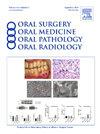Recreational drugs induced pemphigus: an atypical clinical and histologic presentation
IF 1.9
3区 医学
Q2 DENTISTRY, ORAL SURGERY & MEDICINE
Oral Surgery Oral Medicine Oral Pathology Oral Radiology
Pub Date : 2025-07-21
DOI:10.1016/j.oooo.2025.04.035
引用次数: 0
Abstract
Introduction
Pemphigus is a group of autoimmune blistering disease processes affecting the skin and mucosal surfaces. Pemphigus vulgaris is the most common form of pemphigus encountered in the oral cavity. Many causes have been attributed to the initiation of the disease process including drug use. Herein, we present a case of recreational Drug-Induced Pemphigus with atypical clinical and histologic features.
Case Report
A 39-year-old Kuwaiti male presented with a 2-year history of multiple recreational drug abuse, including hashish, ethanol, methamphetamine, and chemical, that triggered schizophrenia. Prior to admission to the psychiatric hospital, he developed oral ulcerations of 1-year onset. ELISA showed elevated DSG-3 and indirect immunofluorescence testing was “suggestive of pemphigus.” On exam, the patient had 2 small deep ulcers in the left buccal mucosa, white keratotic, and rough mucosal changes, and crusted labial verrucous lesions not typical of pemphigus. Multiple lesional samples were examined histologically and showed acantholysis, focal suprabasal epithelial clefting, focal superficial epithelial separation, and dyskeratosis. Focally, there was extensive dyskeratosis and tier keratosis, reminiscent of Darier disease. Direct immunofluorescence (DIF) testing was negative. Additional biopsies were performed from recently developing lesions with less hyperplasia and crusting to further asses the disease process and progression. Dyskeratosis was not as prominent and the diagnosis rendered was suggestive of Pemphigus with clinical and histologic features of Pemphigus vegetans and foliaceous. Systemic corticosteroid therapy was commenced and the patient started showing improvements a week later.
Conclusions
Recreational drug-induced pemphigus can pose a diagnostic challenge when the lesions clinically are not typical of pemphigus. Thorough history-taking and appropriate diagnostic modalities can facilitate early diagnosis and management.
消遣性药物引起的天疱疮:一个不典型的临床和组织学表现
天疱疮是一组影响皮肤和粘膜表面的自身免疫性起泡性疾病。寻常型天疱疮是口腔中最常见的天疱疮。许多原因归因于疾病过程的开始,包括药物使用。在此,我们报告一例非典型临床和组织学特征的娱乐性药物性天疱疮。病例报告:一名39岁科威特男性,有2年的多种娱乐性药物滥用史,包括大麻、乙醇、甲基苯丙胺和化学品,并引发精神分裂症。在进入精神病院之前,他出现了1年的口腔溃疡。ELISA检测显示DSG-3升高,间接免疫荧光检测“提示天疱疮”。检查时,患者左侧颊粘膜有2个小的深溃疡,白色角化和粗糙的粘膜改变,以及非典型天疱疮的结痂性唇疣性病变。对多个病变样本进行组织学检查,结果显示棘层溶解、局灶性基底上上皮分裂、局灶性浅表上皮分离和角化不良。局部可见广泛的角化不良和层状角化,与达里尔病相似。直接免疫荧光(DIF)检测为阴性。对最近发生的增生和结痂较少的病变进行额外的活检,以进一步评估疾病的过程和进展。角化异常不明显,诊断提示天疱疮的临床和组织学特征为素食性天疱疮和叶状天疱疮。开始全身皮质类固醇治疗,一周后患者开始出现改善。结论娱乐性药物性天疱疮在临床表现不典型的情况下,可能会给诊断带来挑战。全面的病史记录和适当的诊断方式有助于早期诊断和管理。
本文章由计算机程序翻译,如有差异,请以英文原文为准。
求助全文
约1分钟内获得全文
求助全文
来源期刊

Oral Surgery Oral Medicine Oral Pathology Oral Radiology
DENTISTRY, ORAL SURGERY & MEDICINE-
CiteScore
3.80
自引率
6.90%
发文量
1217
审稿时长
2-4 weeks
期刊介绍:
Oral Surgery, Oral Medicine, Oral Pathology and Oral Radiology is required reading for anyone in the fields of oral surgery, oral medicine, oral pathology, oral radiology or advanced general practice dentistry. It is the only major dental journal that provides a practical and complete overview of the medical and surgical techniques of dental practice in four areas. Topics covered include such current issues as dental implants, treatment of HIV-infected patients, and evaluation and treatment of TMJ disorders. The official publication for nine societies, the Journal is recommended for initial purchase in the Brandon Hill study, Selected List of Books and Journals for the Small Medical Library.
 求助内容:
求助内容: 应助结果提醒方式:
应助结果提醒方式:


